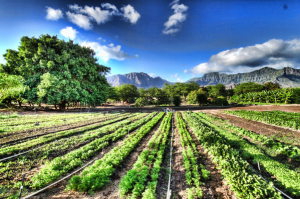How Climate Change is Changing Farming
 Farming was never an easy gig, but lately it’s been downright frustrating.
Farming was never an easy gig, but lately it’s been downright frustrating.
Record heat waves, floods, cold-spells, and droughts are cutting into yields and in some instances ruining entire crops. Analysts warn that such climate change-driven extremes could reduce grain production in G20 countries by up to 8.7 percent by 2020 if no significant action is taken.
Last June’s epic rainfall is a prime example. New Jersey saw an average total of 9.57 inches, 5.55 above the 4.02 average. At our Pennington farm, over 13 inches fell in a 30-day period, wreaking havoc on our more delicate lettuces and brassicas.
“When where we’re getting ¾ of an inch in 20 minutes, the ground becomes completely saturated,” Pennington farm manager says. “All the oxygen is forced out of the soil, and the plants suffer.”
Extreme Weather on the Rise.
According to climate change scientists, such extreme events are likely to increase. As the world’s climate continues to warm, the National Climate Assessment predicts higher rainfall totals and temperatures, along with more intense droughts and hurricanes. Events like the Colorado wildfires, Superstorm Sandy, and the 2010 Russian drought will likely become the new norm.
All of which bodes ill for agriculture.
“Every year now is made of record-setting months in either temperature or rainfall,” he explains. “Rain comes down so heavy that it rips the leaves, making plants vulnerable to disease.”
If there’s any good news, it’s that organic farming seems best poised to handle these extremes.
Organics to the Rescue
 In a report titled, Organic Farming and Climate Change, the FiBL argues that organic agriculture, thanks to its adaptability and reduced dependence on inputs, will fare better than its conventional counterpart. Organically-managed soil retains significantly more water during drought, and resists erosion more successfully during floods. Organic farmers, necessarily more attuned to changing conditions, can more readily swap crops or tweak techniques than those who rely on chemical inputs. And finally, organic agriculture’s diversity—differing crops, fields, rotations, landscapes, and farm activities—ensures the survival of at least some crops in any given season.
In a report titled, Organic Farming and Climate Change, the FiBL argues that organic agriculture, thanks to its adaptability and reduced dependence on inputs, will fare better than its conventional counterpart. Organically-managed soil retains significantly more water during drought, and resists erosion more successfully during floods. Organic farmers, necessarily more attuned to changing conditions, can more readily swap crops or tweak techniques than those who rely on chemical inputs. And finally, organic agriculture’s diversity—differing crops, fields, rotations, landscapes, and farm activities—ensures the survival of at least some crops in any given season.
“Already we’re doing a lot to mitigate extremes,” he says. “We grow our heirloom tomatoes in high tunnels to keep the heavy rains off, and give them shade during heat waves.”
We also incorporates a low pressure irrigation system to make efficient use of well-water during drier times. Grassy buffers around the farm’s perimeter prevent valuable soil from being washed into nearby streams. And the promotion of soil biology aids in moisture retention, structural integrity, and nutrient cycling.
An Uphill Battle.
Organic farms, however, account for only 2 percent of total farmland. And while organic sales have been increasing—5.3% in 2009, 7.8% in 2010, and 9.45% in 2011—conventional agriculture still dominates. To defend against the coming floods, droughts, and heat-waves, we need not only narrow this gap but take significant strides in climate change-resistant technologies.
Part of this includes creating cultivars of drought- and heat-resistant species. And because climate change lengthens growing seasons, new disease- and pest-resistant species too. Irrigation and water use will have to become more efficient. Conservation and reduced-tillage practices will need to be refined. And finally, new crops will need to be experimented with.
“The goal is to build a more resilient system,” he says. “And if you’re doing everything right, your farm will be better suited to handle the ever-changing climate.”
Storm clouds may be gathering on agriculture’s horizons, but humans are nothing if not resourceful and innovative. Put our minds together, and we can solve this puzzle.
